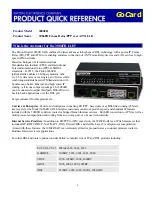
10
Extend and securely tight the corrugated cable along the body of
the vehicle to the place of installation of the GPS-tracker.
Gaging
Gaging of the fuel tank is required to reveal the conformity of the
value received from the gauge with the actual volume of fuel in the fuel
tank.
Tank gaging is a unit-dose filling of fuel into the tank from empty to
full state. Measurement is carried out with a certain filling step, recording
the gauge readings in the gaging table. The tank shape determines
dependence on the level of the fuel volume and it is unique for each
vehicle.
Gaging process recommendations:
Before gaging start, the gauge shall be calibrated in accordance
with the instructions.
We recommend that you perform the gaging procedure at a
constant temperature (+20 °C).
The liquid used for gaging shall be the same as within operation
of the fuel gauge.
Place the vehicle or tank (if removable) horizontally and do not
change its position during the entire process.
The procedure can be performed for each vehicle separately.
Measured liquid shall not contain any impurities, sludge, dirt and
debris.
Gaging shall be carried out in portions of not more than 10% of
the total volume of the tank (the lower portion of the filling ensures more
accurate indications of the system).
After each filling of liquid in the tank, wait until level stabilization,
then record the gauge readings in the table.
Avoid impacts on the tank, which can cause vibration, shaking or
change of the tank shape.
Sealing
Sealing procedure is performed to protect
the device against outside interference during its
operation. The standard equipment consist of 600
mm wire for sealing and 2 seals. If you want to
seal the gauge head, extend the wire through the








































